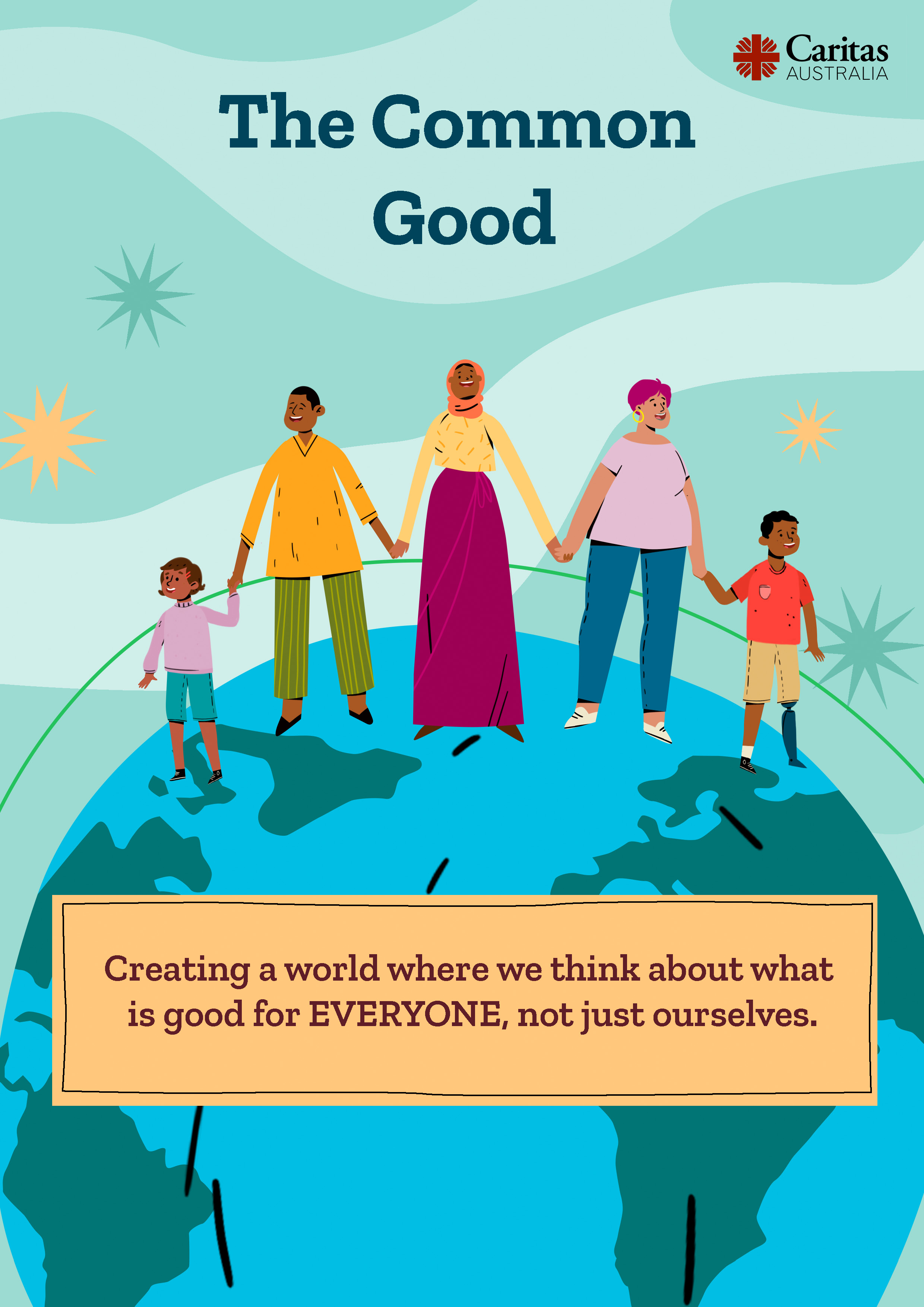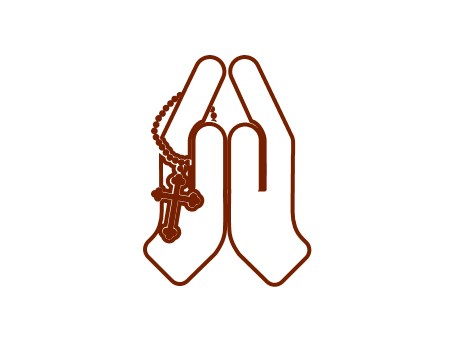The Common Good
Upper Primary

Inquiry Question: What is best for everyone, not just me?
By the end of this unit, students will be able to understand the importance of their decisions and at times these decisions can have positive and negative impacts on humanity and the environment. They will be challenged to do good (Galatians 6:9-10) without expecting things in return as a way in which they can assist individuals and communities in reaching their full potential.
Before you start:
- Watch the Catholic Social Teaching (CST) film, ‘Common Good’, for your own background and familiarise yourself with the Common Good comic.
- Download the various resources referenced at the bottom of this page (worksheets, slides etc.) Print student handouts and have weblinks ready to go on your computer/interactive whiteboard.
- Read/watch the stories and videos linked in this learning sequence to determine if they are appropriate for your class.
- Locate any Scripture passages and copies of Church texts in the learning sequence below.
- Read Scripture commentaries hyperlinked within the learning experience below.
See-Judge-Act-Pray Process
This learning sequence has been created using the ‘See, Judge and Act’ model.
This reflection–action process was first used by a Belgian Catholic priest, Joseph Cardijn (who later became a Cardinal) with Young Christian workers prior to the first World War.
This approach was also recommended in the 1961 encyclical letter written by Pope John XXIII called Mater et Magistra (Mother and Teacher).
Definition
- something "belonging to all and meant for all", e.g. the climate (Pope Francis, Laudato Si' n23)
- an idea that ensures people reach their full potential as individuals and communities
- what happens when individual rights to personal possessions and community resources are balanced with our collective responsibility to meet the needs of others
Student-friendly explanation:
- We should always try to think about what is good for everyone, not just ourselves.
- It’s about living together in a community.
Learning intention
We are learning:
- to display values to be a good citizen
- that our decisions can have an impact on humanity and the environment
- what fair trade is
- the importance of ‘doing good’, even when we feel like giving up

SEE
Play ‘Dead Ant’. This requires students to come together to achieve an outcome. Liken this to poverty, people cannot do it on their own. They need assistance.
Using the 5-3-1 method, ask students: 'What do you know about the Common Good?' Correct any misunderstandings.
Create a Venn Diagram on the screen/board to identify different qualities that students look for in a good friend and a good citizen. Encourage students to explain why the quality being shared is important. Engage students in a discussion based on comparing the qualities for a good friend to a good citizen. Are they the same or different?
Explain to students that qualities that make us a good friend, also makes a good citizen. However, as a good citizen, being kind, generous, loving is on a larger scale and we display these qualities to everyone and everything, putting the needs of others before our own when making decisions. This is achieved when communities of similar beliefs and values work together to achieve a goal.
Read The Common Good comic together as a class. Re-read the comic frame-by-frame and engage students in conversation by using the Think-alouds method. Explore what they learnt about fair trade from the comic and record their ideas.
Teacher's Note: at this point in the lesson, you are wanting to ascertain what they do know about fair trade. If they make incorrect statements, that is ok as you will be able to rectify them in the next activity.
Watch ‘Food Stories – What is Fair Trade?’ video. Pause and start the video at the points identified and follow the instructions. At the conclusion of the video, revisit the discussion points from earlier. Engage students in a conversation on what they now understand Fair Trade to mean, and how by sharing the same beliefs and values they can work together to ensure all everyone is able to reach their full potential.
Source: Rang Maher
Print the Fair Trade and SDG flash cards.
Display the 17 Sustainable Development Goals (SDGs). Explain to students that these goals are a roadmap to creating peace and prosperity for people and the planet by 2030. Review the goals and discuss which goals they believe relate to Fair Trade. Layout the Fair Trade and SDG flash cards so the goals and descriptors are mixed. Begin by having students group the goals together in a single line. Select a student to pick a descriptor and read it aloud. Encourage students to discuss which goal they believe the descriptor matches. Once they have decided which goal, invite the student to place the descriptor next to the goal. Click here for solutions.
Teacher's Note: Fairtrade Premium is ‘an additional sum of money that farmers and workers invest in projects they choose’.
Source: Fairtrade
Our impact
On a T-chart have the headings ‘Behaviour’ and ‘Impact’.
Discuss with the class different forms of behaviours or rules that humanity can display or follow (e.g. purchasing Fair Trade products, throwing rubbish on the ground instead of putting in a bin, installing solar panels, obeying road rules etc) and the impact these can have on their local community as well as their national or global community.
Consolidate learning by explaining that the decisions we make can have an impact on ourselves, others, and the environment. It is important for us to understand this and be informed about what are the issues facing humanity and the environment for us to make the best decisions for everyone and everything. By understanding the SDGs and initiatives like Fair Trade and learning about the work of charities like Caritas Australia, we can learn how we can display the Common Good for humanity and the environment.

JUDGE
Read Philippians 2:1-4
Explain to students that Paul is reminding us that if there is encouragement, comfort, and affection then this will result in unity, love and co-operation. He challenges us to put the needs of others before our own, but not completely avoid caring for our needs. Treating everyone with humility and selflessness, will enable mutual love and unity to grow. Source: BibleRef
Ask students to reflect on the question: Why might we get tired or want to stop doing good?
Invite two students to act out a mini skit. Provide them with the following skit direction and give them 3 min to discuss how they are going to conduct the skit. Students conduct the skit. Select a different pair and repeat the instructions with a different skit direction. At the end of each skit, ask the children how would this scenario make them feel? Some skits may require more than two people.
Skit Directions:
- One leader tries to help the other whilst the other is nasty to them. (People are nasty to us, call us names when we try to be nice).
- One tidies an area and the other doesn’t even notice. Makes a comment about the place being a mess. (Nobody notices – parents don’t notice you’ve done anything when you tidy your room).
- One invites someone to join in a group game and the other excludes them. (Sometimes people make us feel unwelcome and excluded).
Debrief the activity by explaining that ‘sometimes the good things we do go unnoticed, or worse, people dislike us for it anyway. That can make us get tired of doing good. We start to wonder what the point of it all is?! Have you ever felt like that? We all get tired sometimes of doing good things, but we can ask God for help when we feel like giving up. We can’t do it on our own – we need to ask God to help us to keep doing good every day!’
Source: Ministry Ark
Display and read this Pope Francis quote
“It is not enough to love those who love us. … It is not enough to do good to those who do good to us. To change the world for the better it is necessary to do good to those who are not able to return the favour, … Doing good without expecting anything in return. This is what the Father did for us and what we too must do. Do good and carry on!” (General Audience, September 10, 2014)
Explain how being part of God’s family means that we do what is best for everyone. We don’t just think about ourselves, or just our close group of friends, but we look around to see who might be lonely, left out or hurt. Jesus teaches to look out for these people and include them because they are part of our family. We help our brothers and sisters without expecting anything in return.
Read Thu’s case study. Students complete Thu’s Case Study handout. Afterwards students reflect on how Caritas Australia helps people like Thu? using Think-Pair-Share method.

Act
Brainstorm actions they can do at school or in their local community that will contribute to the good of the community.
Choose one action as a whole class or individuals or groups could have a different action each.
Before students start doing the action what impact they will have on the community or the environment. Encourage students to reflect on this while completing their action. Upon returning, invite students to write a personal reflection on their experience.

Pray
Read and display Philippians 2:1-4
Students write a reflection or record a video blog about a time when they made a decision that was for the good of others and not just themselves.
The video blogs could be collected and cut into one clip titled ‘How our class works towards the common good’ and presented at a school assembly or parent evening












